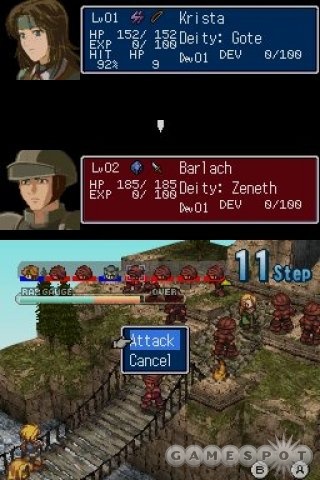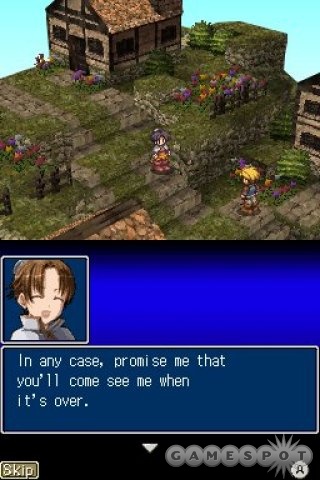Some titles beg to be remade or rereleased; Hoshigami: Ruining Blue Earth, the PlayStation strategy role-playing game, is not one of them. It's not that Hoshigami Remix is bad, but it's wildly inconsistent and harshly demanding even on normal difficulty. It's also not a very good choice for a gamer on the go: Battles are long and the learning curve is steep, so short sessions are not only unsatisfying, they are often impossible. There are some good ideas at work here, but the game asks a lot of you and doesn't give a lot back, which makes playing it feel more like work than fun.
The main character of Hoshigami: Ruining Blue Earth Remix is Fazz, a mercenary who receives a surprise request for help from the king of Nightweld. The kingdom is under attack by the Valaimians, and he needs a hand from Fazz and his soldiers for hire. As it turns out, there is more to the invasion than meets the eye, and it's up to you to keep the powers of the ancients from falling into the wrong hands. It's nothing new to the world of RPGs, though Fazz turns out to be a bright and resourceful hero, and he'll stay interesting long after you stop caring about the plot. There are also some branching story paths that will determine which characters can join your party, as well as a number of alternate endings. It isn't the greatest tale, but there's something to be said for keeping things non-linear.

The basic plot outline may not be too complex, but Hoshigami's core gameplay is quite intricate. At first, it will seem simple enough to anyone that's played a turn-based strategy game before. At the onset of battle, you place your mercenaries on the battle grid, and each one takes turns moving to available squares, attacking an enemy, or performing other available actions. From here, the game breaks free from prevailing standards, most noticeably in how turns function. Each character has an RAP gauge, which stands for “read for action points.” Each action you perform drains the gauge, and the turn is over once the mercenary has fully depleted it. In theory, this means you can move, attack, and use an item all in the same turn, though there are benefits to not consuming the entire gauge: The more energy left in it when you end the turn, the sooner the character's next turn will come. The RAP meter is an excellent addition to the standard gameplay, and fully grasping its benefits is a big key to success in battle.
Were it combined with more intuitive gameplay elements, read for action points could have added some nice spice to orthodox conventions. But you'll find other aspects that have been convoluted to the point of unfriendliness. Spells aren't just spells, they are coins called coinfeigms. Each coin is infused with a particular type of magic, such as fire, earth, ice, or lightning, and each type has a number of different spells that can be earned and cast. Mana has an equivalent in the form of coinfeigm points, but the points are applied to the coin, not to the character. As a result, a character's ability to cast the spell depends on how much energy is left in his RAP meter, as well as how many points remain on that particular coin. Coins can also be upgraded by engraving seals on them, and just as there are many different coins available, so too are there a bunch of seals to apply. Seals and coins fit together in dense ways, so where one seal may increase a coin's effectiveness, another may render it almost useless. You can also engrave seals in pairs, which may enhance the coin further than if you applied each separately. How do you know what the effect is going to be? You don't. You will either need a photographic memory, a spreadsheet, or an FAQ to know how seals will affect coins, and to what extent. It isn't as though the game itself clues you in to this or anything else, so you'll be left to your own devices.
Confused yet? Well, there's more. Each character is aligned with one of six deities, which impacts how effective their attacks will be on other characters. If your mercenary follows Amu, he'll be strong against followers of Zeneth but weak against Gote. Furthermore, you'll earn devotion points as well as experience points during battle. Once a character advances a deity level, he can learn skills and gain (and lose) proficiency with certain weapons. You can also switch deities, enabling you to gain abilities from multiple gods.
One of the complexities, however, is a satisfying one: attack sessions. An attack session is a combo attack, and while pulling one off takes a good deal of patience, completing sessions is one of the few rewarding mechanics in Hoshigami. In standard combat, you time a button press with a battle meter to determine how much damage you'll do. In an attack session, you set up your characters in advance and perform a shoot attack, which knocks enemies backwards. If you time everything carefully, you can bounce an enemy from mercenary to mercenary like a pinball, doing a ton of damage and potentially earning an item for your troubles. It's hard to do, but when you do it, it gives you a real sense of accomplishment in a game that's high on work and low on returns.
Complex and detailed game mechanics aren't bad things, nor is it necessarily a problem to aim at a decidedly hardcore audience. But even if you are an experienced strategist and quick to pick up on all of these elaborate contrivances, you're still not likely to enjoy the experience. Keeping track of coinfeigms, deity relationships, and your RAP meter is a lot of work, but you will never feel all that rewarded. You need to periodically stop and level up in towers specifically created for level grinding, because as difficult as Hoshigami is, leveling up your characters and coins is more important than smart battlefield tactics. You will also discover halfway through the game's sixty or so hours that it is incredibly imbalanced. If you make the mistake of putting more effort into standard weaponry, you are in for a rude awakening and likely to throw the game away in disgust: Coins are essentially the only way to finish the game, and about twenty-five hours in, your melee fighters will be useless. Magic is highly overpowered, which means if you concentrated solely on improving coinfeigms, you should be able to eke by without too many issues. If you went with a more balanced party, or worse yet, built it around physical weaponry, you will be easily overpowered and potentially incapable of finishing unless you have a will of steel.

If you played Hoshigami on your PlayStation and for some reason feel obligated to check for differences, you will find a new playable character, a new (and thankfully improved) soundtrack, and other minor changes. As you can imagine, there is also touch-screen support, yet you'll be unlikely to use it, since variations in map terrain sometimes make it tough to choose the square you want. The game doesn't make very good use of the top screen during battle either, relegating it to showing unit statistics and not much else. The chance to add some flash to the plain isometric visuals was there for the taking, but the unique capabilities of the DS were left mostly untapped, which is just another reminder that some titles are better off left as distant memories. Not that it looks or sounds terrible. The character sprites are fine, and you may notice small details, like the way archers scan the horizon while you queue up their attack. But coin effects are simple and unexciting, so battle has very little pizzazz, and the game is missing personality as a result. Some sound effects are OK, while others are just weird, like the banshee wails that female units emit upon defeat.
Needless to say, Hoshigami: Ruining Blue Earth Remix is not a handheld-friendly game, let alone user-friendly. To play it, you need to find a quiet corner, grab your notes, and settle in. Complexity can be a good thing of course, but here, the resulting gameplay is just frustrating without anything to compensate for it. If you're into strategy RPGs, the ideas may interest you, but even the most devout players will decry the unbalanced combat and emphasis on level-grinding over strategy. As a result, this is a game that's not really for anyone.